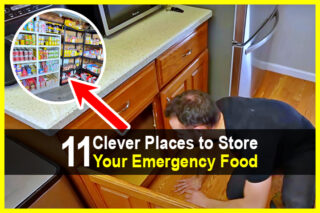Estimated reading time: 9 minutes
One thing we have learned in recent years is that we never know when we might face a crisis that will disrupt our food supply. Whether it's a severe weather event, public health crisis, or civil disturbance, we have seen how quickly we can lose access to what we need to survive.
As a result, nearly a third of Americans are doing some sort of disaster preparations. According to a recent finder.com survey, these folks have spent a combined $11 billion over the past year on emergency supplies. Not surprisingly, food and water top the list.
When you are investing in the time and space for a survival pantry, you want to choose foods that are nutritious and easy to prepare. But you also need foods that will last as long as possible.
This article offers an alphabetical list of 20 foods that can last two decades or more when stored properly. We'll also include storage tips to follow so you can have peace of mind that your family will have provisions if a disaster strikes.
Want to save this post for later? Click Here to Pin It On Pinterest!
1. Beans
Beans are a convenient source of protein, fiber, and carbohydrates. You can mix this versatile basis with rice, add them to a stew or soup or spread them on crackers and chips.
One pound of dry beans provides as much as 1,500 calories and 100 grams of protein. When stored in airtight containers, most dried beans will last 25 years. Properly stored canned beans offer fast meal preparation and can last even longer.
2. Canned and dried fruits
Canned and dried fruit provide necessary nutrients in an emergency food situation. Choose canned fruits packed in their own juice or water for best results. And be sure to store dried apricots, prunes, dates, figs, and raisins in airtight containers. This helpful article offers guidance on freeze-dried fruit for long-term storage.
3. Canned and dried meats
Many canned meats can be eaten right out of the container, offering protein and other essential nutrients. However, proper storage is necessary. This article provides a run-down of what you need to know before you stockpile canned meat.
Freeze-dried meats are another excellent option for your survival pantry. After reconstitution, freeze-dried meats have the same texture and nutrients as other meat. When stored in airtight containers, freeze-dried meats will last for decades.
4. Canned vegetables
When canned foods are stored properly, they can last and last. Chemists working with the National Food Processors Association chemists analyzed a 40-year-old can of corn from a California basement. They found that the contents looked and smelled like freshly canned corn. No contaminants were found, and most of the nutrients were still present.
Additionally, a U.S. Army study of canned food stored for 46 years found them to be in good condition and safe to eat. So maybe it's time to stock up on peas, carrots, tomatoes, and your family's other favorites.
5. Flour
As with many foods, oxygen is the enemy of this pantry staple. However, storing flour in airtight containers limits the harmful effects of oxygen. The past place for long-term storage is the freezer. Check out this video for re-packaging ideas for your survival stash.
6. Ghee
Nicknamed survival butter, ghee is a form of clarified butter you can use to cook and flavor food. You make it by melting butter and skimming or straining out the solids. Ghee contains vitamins A and K2 and other nutrients, such as butyric acid, which is good for the gut, and it has a delicious flavor along with an indefinite shelf life when stored properly. Here's how to make ghee at home.
7. Hardtack
You've probably read about hardtack in Civil War tales. But this survival food has its roots in ancient cultures, including the Ancient Egyptians and Romans. The basic ingredients of these dense biscuits are flour, salt, and water. Here's how to make hardtack that can store for decades.
8. Honey
Due to its natural resistance to microbial growth, honey has an indefinite shelf life. The sweet substance can crystalize and harden in long-term storage, but it is still safe to eat. To remove the crystals, place the jar in warm water for about an hour until the honey returns to its liquid state. This article offers tips for long-term honey storage.
9. Lentils
Lentils are packed with protein and fiber and can remain fresh and nutritious for several decades under the right conditions. You can use lentils as a rice or pasta substitute or add them to soups and stews. Here are tips for selecting and storing lentils long-term in your emergency pantry.
10. Maple syrup
Did you know that maple syrup is packed with Vitamin D? And an unopened bottle of maple syrup will last indefinitely in your survival pantry. Here are tips for canning maple syrup for long-term storage,
11. Nut butter
Peanut butter and other nut or seed butters contain protein and healthy fats. While an unopened jar of peanut butter usually lasts a year or more when stored properly, powdered peanut butter can remain in good shape for decades. You can reconstitute it with water as needed. Here are ways to use powdered peanut butter.
12. Pasta
Dried pasta can last for 20 years or more when stored in airtight containers. This inexpensive staple works as the foundation for many meals. As with rice, whole wheat dry pasta has a much shorter shelf life. Here are dos and don'ts for storing pasta in your survival pantry.
13. Pemmican
A mixture of dried meat, fat, and dried berries, pemmican is often called the “ultimate survival food.” Native Americans stored and ate pemmican centuries before refrigeration. Here are instructions for making this long-lasting survival food.
14. Potato flakes
Potato flakes (also called instant potatoes or dehydrated potatoes) are inexpensive and easy to prepare with water. Two keys to long-term storage are to avoid added flavorings and keep the flakes away from moisture by storing them in airtight containers. Here are ideas for using potato flakes in your meals.
15. Powdered milk
When left in its original packaging, powdered milk lasts only a couple of years. However, if you transfer it into nitrogen cans, it can remain usable for a couple of decades. Mixing instructions vary somewhat by brand, but you can expect to need about eight ounces of cold water and four teaspoons of instant milk powder to make a glass of milk.
Many families prefer milk alternatives these days. Check out this article for guidance on the long-term storage of alternative kinds of milk.
16. Rice
You can't beat rice as an inexpensive basic food for long-term storage. Under optimal conditions, white rice can last for several decades on the survival pantry shelf. However, keep in mind that the oil in the bran layer of brown rice significantly lowers its shelf life. You can learn about rice storage here.
17. Rolled oats
Oats often serve as a main ingredient in cookies, breads, pancakes, and protein bars. And, of course, they can be the main ingredient of a healthy, filling breakfast. Rolled oats are oat groats that have been steamed and dried into flakes. This process stabilizes their healthy oils, allowing for three decades or even longer in the proper storage environment. Here's more on this survival pantry staple.
18. Soup
Canned soup provides a convenient survival meal. If necessary, you can even eat canned soup right out of the can without any preparation. All commercially-canned foods must be appropriately stored for the best long-term results. You can also add dry soup mixes to your survival pantry,
19. Tea and coffee
Don't forget your favorite comforting beverages when you're preparing your long-term pantry. Instant (freeze-dried) coffee will last more than 25 years in its original container. Here is how to make instant coffee from your own coffee beans.
You also can add tea to your survival pantry. It may lose some of its flavor as the years go by, but tea remains safe to drink. Here's how to store tea so that it stays at its best.
20. A to Z extras
The last entry on our list is one you can modify for your own family's needs. When faced with a crisis, you'll want to make your meals as comforting as you possibly can. Many of the flavoring ingredients, dried spices, and cooking agents you use for baking and cooking will last for decades when stored correctly in airtight containers.
Here is guidance for the long-term storage of spices. They may lose some of their strength, but they will remain safe to use. What you stock up on is up to you, but here are some options to consider:
- Baking chocolate
- Baking powder
- Baking soda
- Chili powder
- Cinnamon
- Cocoa powder
- Coriander
- Cornmeal
- Cornstarch
- Cumin
- Curry powder
- Ginger
- Garlic powder
- Granulated sugar
- Italian seasoning
- Ketchup
- Lemon juice
- Minced onion
- Mustard
- Paprika
- Pepper
- Salt
- Salsa
- Soy sauce
- Vinegars (white, red, apple cider)
- Yeast
General tips for long-term food storage
The foods on our list will only last for 20 years or more under proper storage conditions. Here are some tips for setting up your emergency pantry.
- Choose a cool, dry, dark location that is away from humidity, heat sources, and sunlight.
- Keep food off the floor.
- Use Mylar bags and oxygen absorbers to prevent damage from air, moisture, and pests.
- For added protection, place Mylar bags inside a food-grade bucket that is closed with a lid.
- Label packages with the date of packaging and storage and any instructions.
- Inspect your pantry regularly for signs of pests, mold, and mildew.
- Be aware of color changes, leaking, or unusual odors.
- Use the first in, first out (FIFO) method of rotation. Replace items you use with a fresh supply.
- Trust your senses when it comes to food. For example, if it smells off, don't eat it.
You don’t need to have a large, unused space to start an emergency pantry. A closet can work well. For more information on long-term food storage methods, here are some resources to consider.
- The Prepper's Ultimate Food-Storage Guide by Tess Pennington, Julie Languille, Daisy Luther, and Shelle Wells
- The Prepper's Pantry by Collin Bradford
- A Guidebook to Acquiring Food, Stockpiling, Storing, and Preparing for Survival by Geoffrey Richards
- Survival Food To Stockpile by Raymond L. Hillman
Like this post? Don't Forget to Pin It On Pinterest!
You May Also Like:












